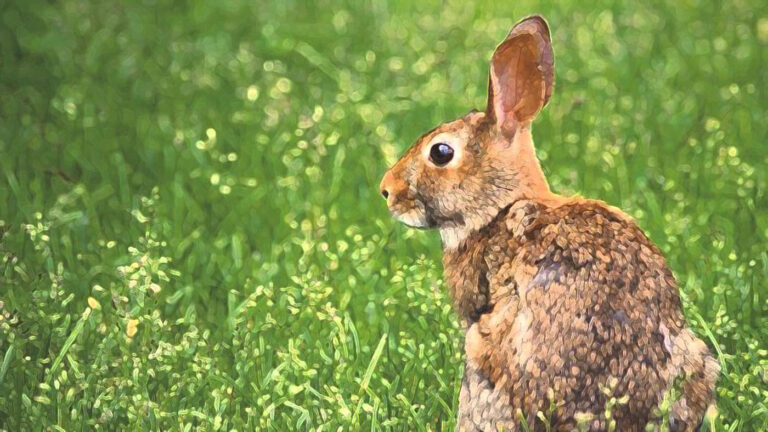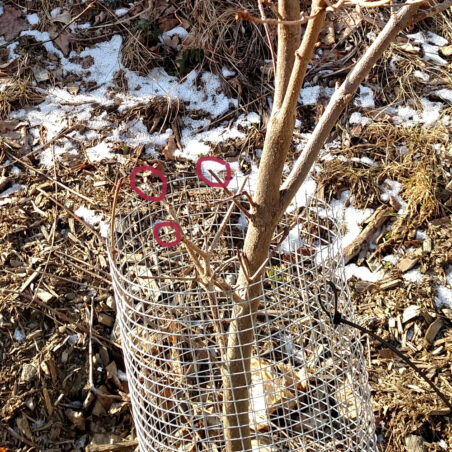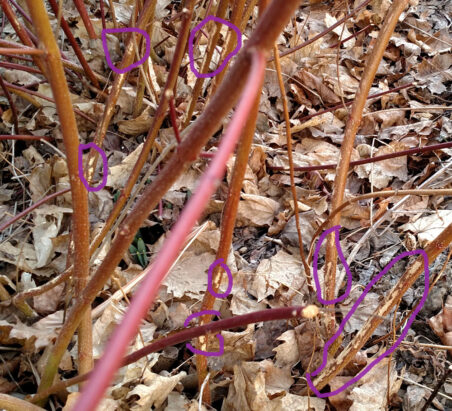Keeping Rabbits and Voles Out

Cute rabbits spotted in the yard or by the roadside get squeals of delight from children. However when gardens and ornamental shrubs get nibbled beyond recognition, the squeals are more likely shrieks of frustration. Browsing on plants in yards, these animals thrive.
What damage looks like
When you see neat-clipped, browsed vegetation, often appearing overnight; you have rabbit damage. You might also see obvious animal tracks and scat in the form of small piles of pea-sized pellets. Deer droppings look similar but are larger in size. Woodchucks will take the whole plant.

Rabbits clip branches cleanly as if you pruned them. These budding tips rose out of the mesh fencing above the snow where rabbits could reach them.
Gnaw marks about 1/8 inch wide and 3/8 inch long in irregular patches and various angles indicate vole damage. Voles or meadow mice can gnaw completely around the trunk or roots of a tree. If gnawed completely around the trunk, the tree won’t receive the proper flow of nutrients and water. This girdling and can kill a tree. Partial girdling will weaken a tree and limit fruit production. These marks combined with one-inch wide burrow holes, runways and greenish small droppings confirm the presence of voles.

Voles gnawed many stems of this red-twig dogwood. A prolific grower, it can withstand the vole damage.
Start with a Barrier around Young Plantings
A fence measuring 2 to3 feet high will keep rabbits out of a flower or vegetable garden. Use chicken wire or hardware cloth (a heavy gauge woven wire mesh, fencing material) staked about every 4 feet and buried into the ground at least 8 inches (preferably 12 inches). Make an outward L-shaped bend at the bottom to prevent animals from burrowing down and underneath the fence. Hardware cloth with ¼” opening squares will keep out moles and voles as well. Because voles travel below the surface also, the buried fencing can prevent unseen damage.
For perennial display gardens, the barrier can be removed after 2-3 years when the perennials will likely withstand some browsing of the new growth, a rabbits preferred food.
Modify the habitat to discourage damage
Both rabbits and voles prefer dense vegetative cover and weeds. Overly deep mulch will encourage voles, too. Limit their habitat by mowing grass short and removing ground cover near the garden or around trees. By exposing them to predators, you make those locations less appealing to the rodents. Deep snow-fall will hide rabbits and voles, too. Clear snow from around vulnerable young trees in a 4-foot radius to keep pests away.
Try Repellents where Barriers are Difficult
Commercial repellents with the active ingredients capsaicin, predator urines and/or concentrations of natural oils can work to repel rabbits in the yard or garden. Read labels before using these products on plants that will be eaten. Remember to always follow the directions on any commercial product purchased.
Maybe make your own stinky spray
The following homemade hot pepper repellent can also be effective, when applied to flower bulbs and plants:
Ingredients:
- Medium yellow onion, chopped
- Jalapeno pepper, chopped
- 1 tablespoon Cayenne pepper.
Directions: Boil ingredients for 20 minutes in 2 quarts of water. Let it cool then strain through cheesecloth. Liquid is caustic – use gloves and protect eyes. Apply with spray bottle.
This homemade repellent will deter any animal where it is applied and will last 3-5 days. This recipe is courtesy of Urban Wildlife Rescue, Inc. If using this mixture with a vegetable garden, make sure to wash vegetables well before eating them. Remember that this homemade repellent and other repellents need to be reapplied regularly, and repeated after heavy rain, in order to be effective.
Mechanical ‘Scare’ Devices
Sprinklers triggered by motion detectors can also discourage rabbits from investigating gardens. Statues of owls, especially with a bobble head action, will keep pests away if you have cleared their habitat as suggested above. Move the statue around the property occasionally to make it more lifelike.
Winter Tree Protection
Protect tree bark from rabbit-chewing by fencing trunks with hardware cloth or wire mesh. The cloth or mesh should be wrapped loosely around the tree with at least four inches of space between the tree and the cloth/mesh to allow for growth. Make the fencing tall enough to extend into the ground about 6 inches, and at least 2 feet above the snow line. Hardware cloth and wire mesh can be purchased from most hardware stores. Coil the strips of mesh into a cylinder 2 feet tall around the trunk and fasten with plastic zip ties. The ties will hold the mesh tight. You can cut the ties in spring, remove the fencing strips and save them for use next fall.
Our Summer Garden Advice
By mid-summer, perennial gardens can start to look overgrown, annual flowers begin to fade, and bugs may be munching on your vegetables.
Summer Articles